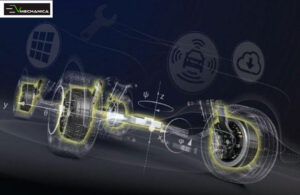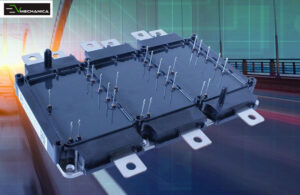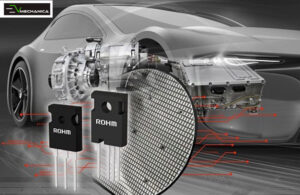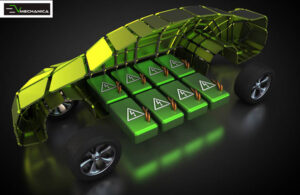 Driven by the aggressive take of major government policies promoting clean mobility solutions across the globe, the Electric Vehicles (EVs) market is expected to become on par with regular ICE-based vehicles in a few years.
Driven by the aggressive take of major government policies promoting clean mobility solutions across the globe, the Electric Vehicles (EVs) market is expected to become on par with regular ICE-based vehicles in a few years.
Against this backdrop of mandatory regulations, consumer acceptance of EVs has also seen a gradual spike as the prices of fuels increases day by day.
One of the key components that enable the efficient operation of EVs is the use of silicon carbide (SiC) semiconductors.
Keeping this in mind, let’s discuss the Role of SiC in EVs and the penetration of this integration has reached so far.
What is SiC and How Does it Work?
 SiC is a material made from silicon and carbon atoms that are arranged in a specific crystal structure. It is a type of semiconductor, which means it can conduct electricity but not as well as a metal. SiC in EVs offers several unique properties that make it well-suited for use.
SiC is a material made from silicon and carbon atoms that are arranged in a specific crystal structure. It is a type of semiconductor, which means it can conduct electricity but not as well as a metal. SiC in EVs offers several unique properties that make it well-suited for use.
One of the most vital properties of SiC is its high thermal conductivity, which means it can dissipate heat quickly and effectively. Role of SiC in EVs because the high-power electronics generate a lot of heat, and if not dissipated quickly, it can lead to thermal runaway and damage to the system.
Another key property of SiC is its high electrical breakdown field strength, which allows it to withstand high voltage and current levels without breaking down. SiC in EVs plays a significant role in its operations as the high-voltage battery packs and power electronics require semiconductors that can handle high voltage and current levels without breaking down.
Role of SiC in EVs & Power Electronics
 SiC is used in several types of power electronic applications in EVs, including the inverter, DC-DC converter, and onboard charger.
SiC is used in several types of power electronic applications in EVs, including the inverter, DC-DC converter, and onboard charger.
An inverter is a key component in EVs that converts the direct current (DC) from the battery pack into alternating current (AC) that can be used to drive the electric motor.
SiC-based inverters offer several benefits over traditional silicon-based inverters, including higher efficiency, smaller size, and higher power density.
The DC-DC converter is another important component in EVs that converts the high-voltage DC from the battery pack to a lower-voltage DC that can be used to power the vehicle’s electronics. SiC-based DC-DC converters offer similar benefits to SiC-based inverters, including higher efficiency and smaller size.
The onboard charger is used to charge the EV’s battery pack and the SiC-based charger has higher power density, smaller size and increased efficiency.
Perks of SiC in EVs
The benefits incurred by integrating SiC in EVs are immense, including:
- Increased Efficiency: Impact of SiC in EVs is vital as their integrated products have higher efficiency than traditional silicon-based power electronics, which means they waste less energy as heat and can increase the range of the EV.
- Smaller Size and Increased Power Density: SiC-based power electronics are generally smaller in size and have higher power density than traditional silicon-based power electronics, which means they take up less space in the EV and allow for more compact designs.
- Increased Reliability: SiC-based power electronics are more reliable than traditional silicon-based power electronics because they can withstand higher voltage and current levels without breaking down.
Market Leaders of SiC in EVs
 SiC technology integration in EVs have boosted the charging time of EVs. For example, Cree, a company specializing in SiC technology, has developed a SiC-based charger that can charge an EV in as little as 20 minutes, compared to the several hours it can take to charge an EV with a traditional charger.
SiC technology integration in EVs have boosted the charging time of EVs. For example, Cree, a company specializing in SiC technology, has developed a SiC-based charger that can charge an EV in as little as 20 minutes, compared to the several hours it can take to charge an EV with a traditional charger.
This is due to the high-power density of SiC-based chargers, that enables them to deliver more power to the EV’s battery pack in a shorter amount of time.
Another major company that is at the forefront of SiC in EVs technology is Infineon Technologies. They have developed a range of SiC-based power electronic components, such as inverters and DC-DC converters, that are used in EVs by several major automotive manufacturers. They claim that their SiC-based components can increase the efficiency of EVs by up to 10% compared to traditional silicon-based components, which can result in a significant increase in the range of the EV.
ROHM Semiconductor, a leading SiC device supplier, is also actively developing SiC in EVs devices traction inverters, charging devices and DC-DC converters to meet the growing demand for EV components. They have also developed a SiC-based inverter for EVs that can operate at high temperatures, which means it can handle the high thermal loads that are generated by the EV’s power electronics.
As the EV market continues to grow, we can expect to see more companies investing in SiC technology to improve the performance and efficiency of EVs.
Impact of SiC in EVs has already been proven to be a game-changer in the EV industry and its potential for further innovation is immense.

